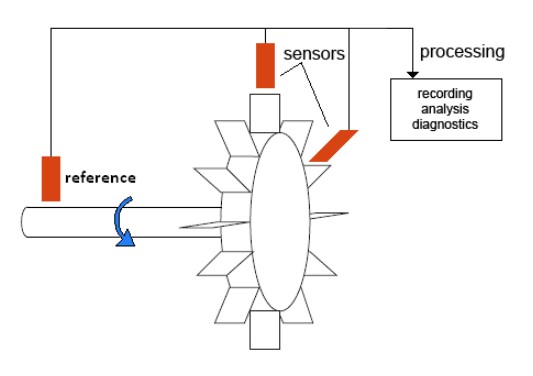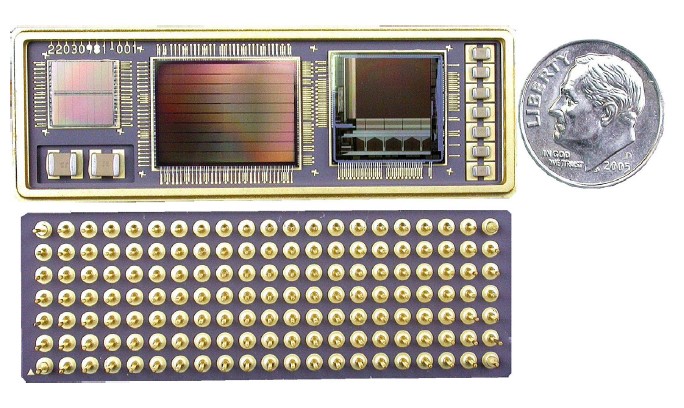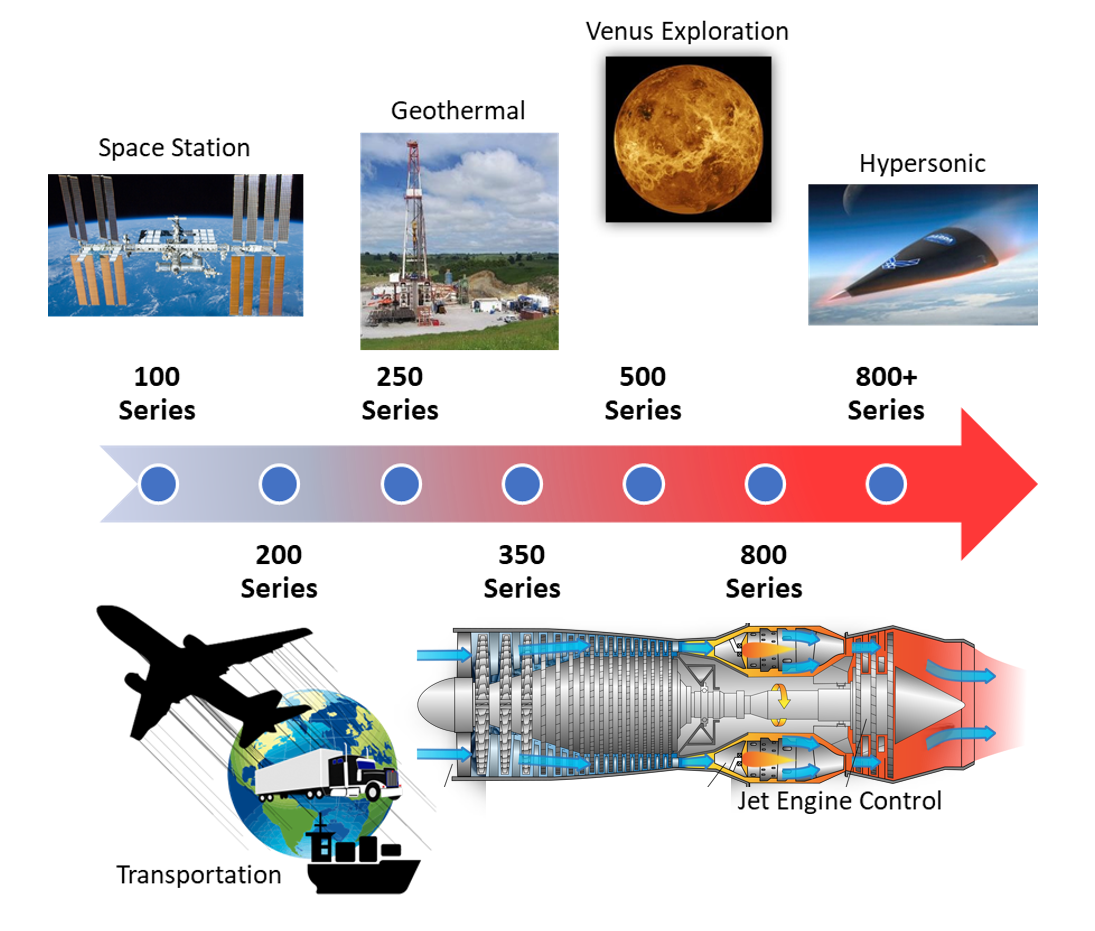Extreme environments require electronic systems capable of surviving beyond the MIL-STD operating temperature range of -55°C to +125°C. This FAQ series will go to extremes and look at super hot electronics (up to 800°C) and cryogenic electronics. Part one of this series looks at electronics that operate in extreme heat. Part two will look at electronics that operate at cryogenic temperatures. Part three will consider the various methods available to create cryogenic environments.
Applications such as deep well and geothermal logging (sensor, gauge, and data acquisition, etc.), automotive under the hood, aircraft, industrial process monitoring, nuclear reactors, turbine engines, and rockets require robust electronic devices that can operate at temperatures above 125°C, in some instances at 450°C (842°F), and beyond. And development work is underway on high-temperature modules rated for operation at 800°C for hypersonic aircraft.
Turbo blade tip clearance
Non-contact sensors are used to detect the blades in a turbine by picking up an edge as the blade passes by. Blade tip timing (BTT) can be used to detect FOD (Foreign Objects Debris) in the turbine as FOD can affect the movement of the blade tips. BTT assumes that the movement of the blade tips is slower than the shaft rotation. If the time difference of the passing blade tips is not constant, then there is “blade flutter.” Analysis of the blade fluttering can determine if there is a problem before a failure occurs.

Optical sensors are used regularly for blade tip timing, but they are prone to contamination and require regular cleaning. Eddy current-based sensors can be a good alternative as they are relatively immune to contamination and can offer detection capability on a par with optical-based sensors. Kaman’s sensors can be used to pick up the turbine blade as it passes by. Kaman has sensors rated to 400°F (204°C) with some rated to 1100°F (593°C).
Turbine engine control electronics
Honeywell International offers its HTMOS products for distributed aircraft and ground-based turbine engine control applications, including remote pressure transducer communication bus interfaces, digitally networked actuator controls, and digital engine controllers that have to operate in “hot” environments. Specified for operation up to 225°C, these devices are also suited for industrial controls, down-hole oil wells, nuclear reactors, and other high-temperature environments. The devices are packaged using a hermetically sealed micro-chip module (MCM) packaging and are rated for continuous operation for up to 20,000 hours at temperature.

They are fabricated with a dielectrically isolated high-temperature process and, in some cases, are specified to operate for one year at 300°C, but with derated performance. Available devices include microcontrollers, gate arrays, analog-to-digital converters, SRAM, and linear regulators. Honeywell also offers MultiChip Module (MCM) technology that can integrate ASICs, memory, and other solid state or passive devices into a single or double sided MCM.
Geothermal wells and hypersonic jets
Ozark Integrated Circuits Inc. (Ozark IC) is working on developing a communication drill pipe system that supports directional drilling in high-temperature geothermal wells by providing computational power at the drill head and linking it to a control base at the surface. There are as many as 200,000 exojoules in untapped, carbon-free energy available from geothermal resources, 2,000 times the annual consumption of primary energy in the U.S. To effectively develop these next-generation geothermal resources requires a directional drilling system capable of operating at 450°C, but most existing commercial directional drilling systems are limited to about 160°C (320°F).
The technology being developed for geothermal resources will be transferrable to space exploration. The conditions inside a deep geothermal well, for example, are similar to the Venus surface, high temperatures, high pressures, and corrosive acids.
According to Ozark IC, there is, therefore, an urgent need for:
- High-temperature electronics that will provide computational power all the way to the drill head at 450°C to continuously sense conditions and implement instructions, and
- A communication system that can bring environmental information (pressure, temperature, drilling direction, etc.) from all points in the well to the surface and instructions from the surface to the drill head (drilling direction, speed, stop, etc.)
Ozark IC is developing a family of high temperature “smart’ modules that can operate up to 800°C (1470°F). These eXtreme Node (XNode) modules, capable of operating in these regimes with integrated processing in addition to sensing, are being developed for a variety of applications ranging from hypersonic and jet engines to space exploration (including the ~500°C Venus surface) and geothermal exploration.

Ozark IC utilizes Silicon Carbide CMOS technology to design dense, low-power circuits that can operate across a 500°C temperature range:
- Scalable from gate drivers to microcontrollers
- Digital/analog/mixed-signal design expertise
- Designs from -180°C to 500°C
Ozark IC designs high temperature integrated circuits using Silicon Carbide JFET-R technology:
- Take measurements in-situ at temperatures up to 600°C
- Ozark IC has JFET models and digital/analog/mixed-signal design expertise
- Designs from -180°C to 600°C
Interconnects for high temperature, high-pressure systems
Hermetic Seal Corporation (HSC) is an expert in the design and manufacture of high pressure glass-to-metal sealed electrical bulkheads for the down hole oil and gas logging instrument market. HSC’s standard double O-ring high temperature high pressure bulkheads are designed to function in the most severe of operating conditions and have been exposed to a combination of pressures and temperatures in excess of 25,000 PSI at 400°F (204°C). Custom designs can meet even higher pressures and temperatures up to 30,000 PSI at 500°F (260°C). HSC also offers alternate glass materials to withstand special circumstances including, temperatures up to 800°F (426°C) at lower pressures and extreme levels of thermal cycling such as -85°F to +800°F (-65°C to +426°C), also at lower pressures.
The next FAQ is this series will look in the opposite direction in terms of temperature and consider cryogenic environments and the types of electronic systems that operate at extremely low temperatures. How those cryogenic environments can be created will be the topic of the third and final FAQ.
References
High-Temperature Communication Electronics for Directional Drilling, Ozark IC
High temperature, high pressure bulk heads, Hermetic Seal Corp.
Honeywell High Temperature Electronics, Honeywell
Turbo Blade Tip Clearance, Kalman Precision Products

